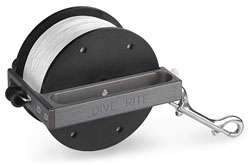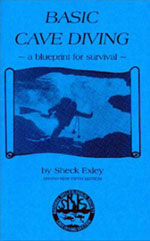| Laying Line in Caves |
 |
| Written by Tony Richardson |
| Saturday, 23 April 2011 12:39 |
|
The system I will outline here relies heavily on the KISS principle, is easy to execute, and even easier to undo when reeling in and exiting a cave.
The secondary tie-off is secured just inside the cave or cavern entrance in the event the primary tie-off is interfered with. A clove hitch around a projecting rock or log is a simple but effective knot to use in this situation. See Diagram 2. For the remainder of the dive the primary objectives when laying the line are to keep the line out of traps, position the line so that divers do not get entangled, and ensure the line is reasonably taught. All of these objectives can be achieved by using line wraps and placements (or tuck unders) rather than time (and line) consuming knots. To execute a line wrap pass the reel of line around a rock outcrop and then pass it back over the line prior to the outcrop. Alternatively, a bight or loop of line can be taken, twisted once, and then placed over the anchor. See Diagram 3. With due consideration for direction of pull, a correctly executed and positioned line wrap is very secure as the opposing forces of the incoming and outgoing lines (from the anchor point) counteract each other and lock the loop of line tightly around the anchor. Line placements (or tuck unders) are even simpler. The boulders, rocks, ledges and outcroppings that make up the natural cave environment are used to simply position the line to where you want to go. See Diagram 4. Smaller rocks can also be placed on top of the line to keep it in place. All caves are suited to this method of laying line. Only rarely should pitons or weights or silt screws be required as anchors or tie-off points. It is important not to wrap the line too frequently. If wraps do come adrift, this could result in a lot of slack line. Line placements and tuck unders are more effective in this regard. Where possible, the line should be laid close to the floor and off to the side so that a diver can swim beside the line while visually referencing its location. The line should be laid in such a way that divers can easily follow it using touch contact if they have to exit without visibility. The techniques outlined above should be initially developed and practiced out of the water. Land drills are an essential precursor to any in water skill training with an instructor. Having the skills and techniques to quickly and effectively lay and retrieve line can only make your cave diving safer and more enjoyable. |
 Laying line in any site from Cavern through to Advanced Cave basically follows the same procedure. There are four types of tie-off: primary, secondary, wrap and line placement (or tuck under).
Laying line in any site from Cavern through to Advanced Cave basically follows the same procedure. There are four types of tie-off: primary, secondary, wrap and line placement (or tuck under). Firstly, the primary tie-off is easily secured to an anchor when there is a large loop pre-tied in the end of the line. Underwater at the anchor you create a large "slipping loop" by wrapping the loop-end of the line around the anchor and then passing the reel through it. Then make an additional wrap. See Diagram 1. The primary tie-off must always be positioned to allow a direct ascent to the surface from that point.
Firstly, the primary tie-off is easily secured to an anchor when there is a large loop pre-tied in the end of the line. Underwater at the anchor you create a large "slipping loop" by wrapping the loop-end of the line around the anchor and then passing the reel through it. Then make an additional wrap. See Diagram 1. The primary tie-off must always be positioned to allow a direct ascent to the surface from that point.